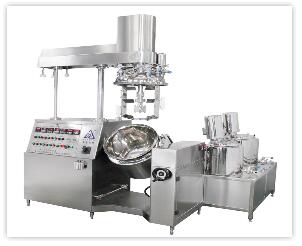Cream/Ointment Production

Emulsifier
 Product Details
Product Details
Pharmaceutical cream or ointment is used as a means of delivering an active ingredient directly to the required area of the skin. Products can be either a water-in-oil (w/o) or oil-in-water (o/w) emulsion, consisting of waxes, emollients and lubricants dispersed in an oil phase, and a water phase containing emulsifying, stabilizing and thickening agents, preservatives and in some cases, colorant. Active ingredients are dispersed in either phase or added when the emulsion has been formed and allowed to cool.
Manufacture of pharmaceutical creams and ointments presents a number of challenges; A GMPMax emulsifying mixer can rapidly disperse solids into liquids, hydrate thickening and stabilizing agents, break down agglomerates and finely reduce particle and globule size to form stable emulsions and suspensions. Mixing times are dramatically reduced, while product uniformity and consistency are greatly improved.
The key to creating a stable emulsion is obtaining the finest possible droplet size. The more shear energy introduced into the mix, the smaller the suspended droplets will become, creating a fine stable emulsion.
The high shear rotor/stator design of the GMPMax mixer is ideally suited to this application and can easily achieve emulsions with a droplet size of 2 to 5 microns. Finer emulsions down to 0.5 microns can be obtained, depending on the formulation. In many cases, this can eliminate the need for high pressure homogenizers.
GMPMax offers a range of in-tank and In-Line mixers widely used for preparation of emulsions, from laboratory scale up to bulk production units.
When used in the cosmetic industry, homogenization provides more stable, uniform emulsions with higher performance characteristics. In the pharmaceutical industry, the primarily mechanical nature of the homogenization process provides direct access to enzymes, proteins, liposome and intracellular active substances without having to utilize chemical lysis of the membrane. Other effects are seen in the preparation of stable solutions of products with different physical characteristics (proteins, creams, solutions of active principles, oils, vitamins). The increase in the surface area of the micronized particles is also of interest to the chemical and petrochemical industries because of the resulting enhancement of transformation reactions. This also creates further advantages, such as: noticeable reduction of catalyzing substances, intensification of pigment color, enhanced use and reduced quantity of additives, viscosity control of finished products. Crushing of active principle particles generates an increase in surface area, thus enhancing preparation assimilation.
GMPMax turbine emulsifying machine is a coaxial and triple type mixer, suitable to stable homogenizing and emulsifying, the finished granular is very small. The quality of emulsifying depends on the disperse of the granular on the preparation stage. The smaller the granular is, the weaker the trend of accumulation to the surface becomes, thus the smaller the opportunity for the emulsifying to be broken becomes. Relying on mixing of reversed impeller, under the condition of homogenizing turbine and vacuum status, you can get the high-quality effect of emulsifying and mixing.
Structure
This unit applies upper coaxial triple type mixer and hydraulic lifting mode to open the cover. The speed of rapid homogenizing mixer is 0-3500 rpm (frequency control); the speed of slow-speed scraping mixer is 0-70rpm (frequency control); the homogenizing head applies high cutting eddy current type emulsifying mixer. The slow-speed scraping mixer automatically abuts closely to the bottom and wall of boiler. By applying vacuum sucking, this unit can suck in powder material by using vacuum to avoid powder flying upward. The whole process is performed under the vacuum condition in order to keep from the production of air bubble after the material is mixed at high speed and up to hygienic asepsis requirement. This system is equipped with CIP cleaning equipment. The parts of container, which contact the material, are made of SUS316L stainless steel and inner surface mirror polish is up to 300MESH (sanitary level). In order to ensure stability of control part, the electric control parts apply the products from German Siemens. The unit is made completely in conformity with GMP and is the most advanced, ideal ointment and cream production equipment currently in China.
Low-Speed Mixing System
Two reversed low-speed mixing systems, composed of a hanging bracket full of scrapers as well as impeller.
The full automatic movable scraper’s surface is made of PTFE, only working under the condition with material. It’s easy for disassembly and cleaning.
Dynamic balancing coaxial shaft
Outer hanging brackets and inner impellers are made of stainless steel SUS316L.
The timing is controlled by PLC to facilitate the setting of working time.
The speed of the equipped reduction motor can be controlled directly by inverter to 0-70 rpm
The low-speed mixing system produces two independent countercurrent flows inside the material.
One vertical fluid along the center can force material to fluid to the bottom of container. Its function is to convey the material to the bottom of homogenizing-turbine rapidly.
Another circle flow forces the material encircle the inner wall of the mixing container to facilitate the material to make heat-exchange during heating or cooling stage, which can prevent the material from being damaged due to overheat or overcooling.
High Speed Homogenizing Mixing System
High-speed homogenizing-mixing activity is accomplished by one turbine installed on the center bottom of tank.
Turbine is composed of dentate stator and rotor with impeller
Turbine is made of stainless steel SUS316L, rotating parts pass the dynamic balancing coaxial shaft.
The timing is controlled on the control panel to facilitate the setting of working time.
Adjust speed by inverter control: 0-3500 rpm
This kind of structure i.e. executing on the turbine not from the bottom can assure high cleanness of the process project. The reasons are as follows:
a) The material will not be polluted without the influence of motor flange connection.
b) Turbine is made easy for cleaning, maintenance, assembly and disassembly.
c) The bottom of tank is completely smooth without connection and is easy to clean.
d) Assemble a valve on the center bottom of the tank for discharge.
e) The mixing and homogenizing motors are installed on the top of the tank, which is far from the processing area.
f) Strictly ensure the safety of the operators.
Heating/Cooling System
Heated by the steam in the double jackets
The temperature of material in the container may be controlled through temperature sensor signal from the control panel
Temperature control is composed of temperature module and temperature sensor installed at the bottom of the tank. Actual temperature of material may be read correctly.
Cooling is directly accomplished by the external cold water through the jacket.
Vacuum System
Liquid ring vacuum pump is equipped with solenoid control valve at the water inlet.
Vacuum gauge indicates the vacuum in the container. Max value is -0.95Mpa, and the vacuum can kept for more than 10 hours
Vacuum safety switch is designed to keep the upper cover from opening at the state of vacuum.
Air tightness of upper cover is ensured by the silicon filling material on the flange.
Theoretically, max. vacuity is 730 mm/Hg at 20℃. In order to get optimal emulsifying result, air mustn’t enter into the material. For the process under vacuum condition, you’re allowed to add liquid or powder to the container directly
Upper Cover Lifting System
The lifting of upper cover is fulfilled by a series of hydraulic devices. The device is fitted with a safe limit system, which can keep the upper cover stopping at any expected position.
Tilting System of Container
Tilting system of container used for discharge is accomplished by a series of mechanical devices and stops at any angle.
Feeding System
Directly add the material to the tank after opening the cover
Under the vacuum condition, the material will be absorbed into the tank by the suction valve through the strainer. Under the vacuum condition, the additive (powder) will directly enter the turbine through the hoper for excipient and additive mounted on the upper cover or the valve at the center bottom of tank so as to shorten the dispersing time
Discharging System
Discharge the material from the inclined container
Positive-pressure discharging through compressed air is available
Process Control
Observation window is equipped with wind board and lamp with good inner visibility.
Safety System
When the upper cover is open, stop using the mixing and homogenizing motors and vacuum pump
Limit micro switch automatically executes the ON/OFF of the upper cover.
Control device will prevent the water in the empty chamber from reaching the boiling point.
The double-key system for sealing the upper cover accords with current EC safety standard.
Note: different parameters can be customized to the request of users to reach optimal performance.
Key words
Homogenizer, emulsifier, cream/ointment manufacturing machine, vacuum emulsifier
Tube filling machine, laminated tube filling machine, metal tube filling machine
cosmetic, chemical, pharmaceutical and petrochemical industries
Adhesives - Starches - Antibiotics - Cellulose and derivatives - Waxes - Colorants - Cosmetics - Beauty creams - Toothpaste - Detergents - Emulsifying disinfectants - Emulsions - Greases - Latex - Liposome suspensions - Lotions - Emulsifiable oils - Lubricating oils - Pigments - Perfumes - Proteins - Resins - Syrups - Paints - Vitamins
Clients
Copyright © 2020 - AA Pharmatech® Limited









